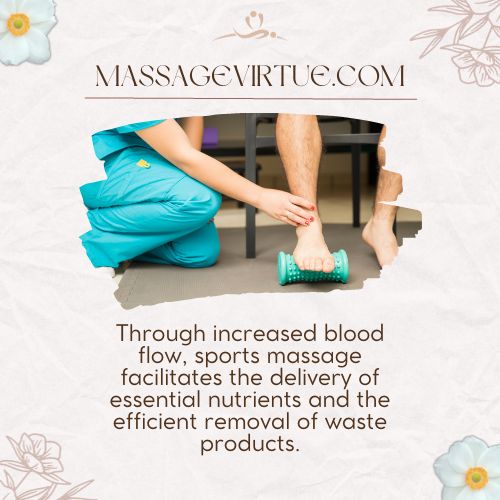If you’ve been suffering from the agonizing foot pain of plantar fasciitis, you’re not alone.
This common condition affects many, from athletes and active individuals to those who spend long hours on their feet.
But what if we told you that there’s a game-changer in the realm of plantar fasciitis treatment? So, can sports massage help Plantar Fasciitis?
It’s called sports massage, and in this article, we’re going to delve into how it can be a valuable addition to your treatment plan.
We’ll explore the benefits, and techniques, and guide finding a qualified sports massage therapist.
What is Plantar Fasciitis?
Before we dive into the details of sports massage, let’s grasp the basics of plantar fasciitis.
This health condition is characterized by inflammation of the plantar fascia, a thick band of tissue that runs along the bottom of your foot, connecting your heel bone to your toes.

When this tissue becomes irritated or overstressed, it can result in debilitating heel pain, especially in the morning or after periods of rest.
Can Sports Massage Help Plantar Fasciitis?
Yes, sports massage can be beneficial for plantar fasciitis. This targeted massage therapy focuses on relieving pain and tension in the affected area.
It improves blood circulation, enhances muscle and tissue flexibility, reduces stress, and promotes faster recovery.
While it may not provide a complete cure, incorporating sports massage into your treatment plan can significantly alleviate the discomfort associated with plantar fasciitis and expedite the healing process.
Benefits of Sports Massage for Plantar Fasciitis
Sports massage offers numerous advantages for those dealing with plantar fasciitis. Let’s explore the benefits of sports massage:
1. Pain Relief
Sports massage offers targeted pain relief by addressing the specific areas of tension associated with plantar fasciitis, providing immediate comfort and relief.
2. Improved Blood Circulation
Through increased blood flow, sports massage facilitates the delivery of essential nutrients and the efficient removal of waste products.

It expedites the body’s natural healing processes.
3. Muscle and Tissue Flexibility
Sports massage reduces tightness in muscles and tissues, enhancing flexibility and decreasing strain on the plantar fascia, improving overall comfort.
4. Stress Reduction
Beyond physical benefits, sports massage brings relaxation, alleviating the stress often linked to chronic pain, and positively impacting your mental well-being during the healing process.
5. Faster Recovery
Sports massage promotes quicker healing by enhancing circulation, reducing muscle tension, and promoting relaxation.
It allows you to return to your active lifestyle with reduced discomfort.
Sports Massage Techniques
Now, let’s explore the specific techniques used in sports massage for plantar fasciitis:
- Deep Tissue Massage: This technique involves applying deep pressure to release tension in the muscles and connective tissues surrounding the plantar fascia.
- Trigger Point Massage: Focused on trigger points within the muscles, this method can provide relief by releasing knots and tight spots.
- Myofascial Release: Targeting the fascial tissue, myofascial release aims to improve flexibility and reduce tightness.
- Soft Tissue Release: By applying gentle pressure to the affected area, this technique can ease muscle tension and promote relaxation.
Complementary Approaches
While sports massage can be a significant part of your plantar fasciitis treatment, it’s important to combine it with other strategies for the best results:
| Approaches | Description |
| Plantar Fasciitis Exercises | Tailored exercises and stretches to enhance flexibility, muscle strength, and pain relief. |
| Plantar Fasciitis Shoes | Footwear with proper arch support and cushioning to alleviate strain on the plantar fascia. |
| Night Splint | Worn during sleep to maintain foot dorsiflexion, preventing morning pain by gently stretching the plantar fascia. |
Conclusion
In the quest to alleviate the pain of plantar fasciitis, sports massage emerges as a promising approach.
It offers various benefits, from pain relief to faster recovery, making it a valuable addition to your treatment plan.
By combining sports massage with exercises, appropriate footwear, and night splints, you can take a proactive step towards regaining your active lifestyle.
Remember that every individual’s experience with plantar fasciitis is unique, and what works best for you may require a tailored approach.
FAQs
What Kind of Massage Is Good for Plantar Fasciitis?
Deep tissue massage and myofascial release are effective for plantar fasciitis. These techniques target tight muscles and the fascia, reducing pain and tension in the foot.
Is It OK to Massage Plantar Fasciitis?
Yes, it’s generally safe to massage plantar fasciitis, but be gentle.
Don’t apply excessive pressure. If it hurts, stop. It’s often better to have a professional massage therapist do it.
Should I Massage My Foot If I Have Plantar Fasciitis?
It can help, but it’s essential to be cautious. Gentle self-massage combined with professional therapy is a good approach.
Avoid overdoing it to prevent further irritation.
Can a Massage Therapist Fix Plantar Fasciitis?
A massage therapist can’t “fix” it completely, but they can greatly help. They can reduce pain and improve flexibility.
A comprehensive treatment plan may also include exercises and proper footwear.


